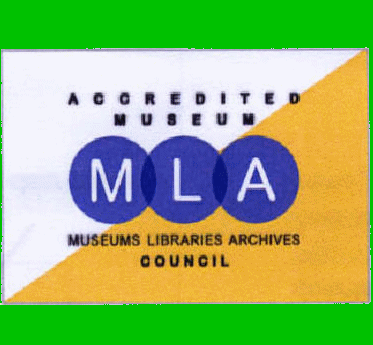Happy New Year!
Museum opening times
The Museum is open to the public, free of charge:
Thursday* to Saturday 10am – 1pm
December 100 Club
This month’s prize numbers were drawn by Councilor Pete Chapman and his wife Wendy and the lucky winners were:-
No. 18 Gillian Yemm £20
No. 15 Lyn Bearcroft £10
If you would like to join our 100 club and be in with a chance of winning, it costs just £1 a month. Ask at the museum for further details.
Christmas Raffle
The Christmas Raffle was drawn on 8th December by members of the visiting public and all winners have been notified. Anyone wanting a list of winning ticket numbers please contact the museum. The sweet jar contained 227 sweets and the winning Teddy Bear name was… Kevin!
Annual Membership Reminder
It’s that time of year when we request you renew your annual membership. Please do so as we rely on your support to stay open. The fee is just £6 for standard membership and £25 for Vice Presidents and if you are a taxpayer and haven’t already done so, please come in and sign a Gift Aid declaration so that we can claim another 25p for each pound given at no extra cost to you. And when you become a member you will receive our Loyalty card to receive a free hot drink in our café every month. This year too we are offering a junior membership to under 16s for just £3 a year to include a free welcome gift.
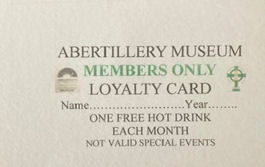
Thank You
Our Christmas Fayre last month went even better than hoped and we made over £700 which will all help with the museum’s running costs. Thank you to everyone who donated items and thank you to everyone who attended including, of course, our volunteers who made it all possible. The first prize in our raffle, the Christmas Hamper, was won by Mrs Jean Colwell who was delighted with it and sent the following message:
To all at the museum, I was surprised and delighted to hear from Peggy [Curator] that I had won the Christmas Hamper. When I unpacked it I realised Christmas had come early! It contained so many good things from bottles of wine and port to things like tea and coffee and all the Christmas luxuries. Thank you and best wishes for health and happiness in 2023.
Betty’s
If you are familiar with Harrogate or York then you will know of Betty’s Tearooms. There are only five of these tea rooms in existence and all in Yorkshire though the story of Betty’s begins in Switzerland…
Fritz Bützers was born in 1885 and orphaned by the age of five. Raised by foster parents, when he was old enough, he left to train as a baker and confectioner. In 1907 he decided to try his luck in England and on his arrival he found he had lost the address of the place he had hoped to settle. He remembered the name of the town sounding something like ‘bratwurst’ and a helpful local suggested to him that maybe it was Bradford? He was helped onto a train heading to Bradford where he quickly found work at the Swiss owned confectioners, Bonnet & Sons.
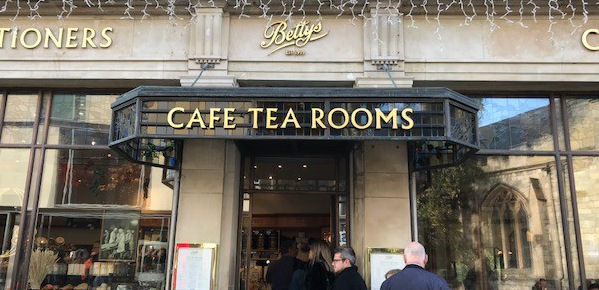
Betty’s York Tearoom spans three floors
It was however Harrogate where he eventually settled and by this time he had changed his name to Frederick Belmont. He fell in love with, and married, the daughter of his landlord and with his in-laws financial help opened his first Betty’s Tearoom in Cambridge Crescent, Harrogate in 1919. It wasn’t long before long the café had quite the reputation for its service, delicious cakes and elegant surroundings. By 1937 nearby York, thanks to it being the home of Terry’s, Rowntree and Craven’s, had become the chocolate capital of Britain and so Frederick brazenly decided to open a café there directly opposite the renowned Terry’s [closed since 1981] café in St Helen’s Square.
In the late 1930s Frederick obtained a licence to sell alcohol and opened a bar in the basement of his York café which proved very popular with servicemen during the war. During this time too he became well known for being able to stretch rations and was providing 20,000 meals a week which proved to be his saving when the army tried to requisition his York café only to withdraw the request when they realised what a great job he was already doing to aid the war effort.
Frederick died in 1952 but his café business is still going strong today, though it never expanded beyond Yorkshire. In 1976 the Harrogate Tearoom moved from Cambridge Crescent to Parliament Street where it stands today and while it is usual to have to queue for a table, in October 2021 the queue stretched from the entrance to the end of the building, around the corner and half-way down the neighbouring street! On this occasion we decided to forego our visit though all their tearooms also have shops and we did purchase a few treats to take home.
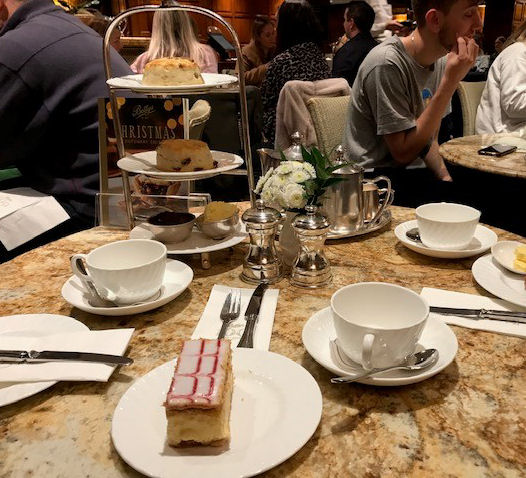
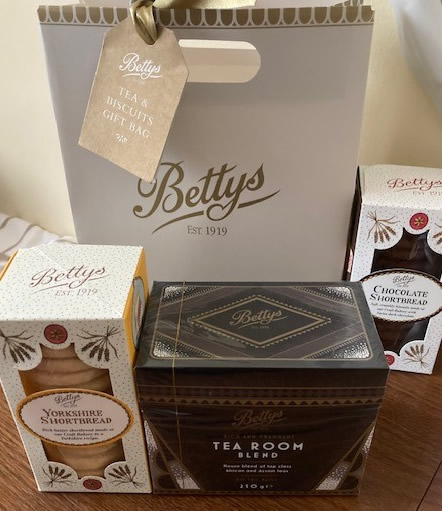 And if you would like to sample their unique blend of tea and other goodies without having to trek to Yorkshire, they offer a postal service. Indeed I was lucky enough to find Santa had left me some of Betty’s tea and bickies. Time to put the kettle on I think…!
And if you would like to sample their unique blend of tea and other goodies without having to trek to Yorkshire, they offer a postal service. Indeed I was lucky enough to find Santa had left me some of Betty’s tea and bickies. Time to put the kettle on I think…!
To read the history of Betty’s or to order goods use this link
Sally Murphy
Live Radio Play
When hubby and I were invited by the Manger, to attend a show at The Met in December, and when I read that it was a ‘Live Radio Play’ of ‘Miracle on 34th Street’, I really didn’t know what to expect however we were both very pleasantly surprised! The best way I can explain it is to imagine you are invited to a studio to watch a live broadcast of a radio show such as say, The Archers, only in this case, the date is 24th December 1949, and you are at the New York City Lighthouse Theater Sound Stage…
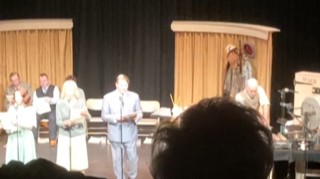
It began with the cast arriving, greeting each other and hanging up their coats. A large illuminated sign on stage told us, the ‘studio audience’ when we were ‘live on air’ and another illuminated sign told us when we were expected to clap!
As is the case with a radio play, all characters had scripts to read from and some actors were playing more than one character and the ease with which they were able to change their voices to create another character demonstrated a great deal of skill. Also of course, sound effects had to be incorporated and to one side of the stage was a large number of props such as a cupboard which was knocked on and opened and closed to simulate a character entering or leaving a room. Another was a pair of shoes that were tapped on the table to make the sound of feet walking down a corridor. Indeed the ‘prop’ man aided by another lady on occasion, worked non-stop as well as playing a character himself!
Every so often, the show paused for ‘a word from our sponsors’ which meant an ‘ad break’ for ‘Bremel Hair Tonic’ and ‘Dux Toilet Cake’ sung to well known Christmas tunes and I must say the singing and harmonising was excellent! Add to that the cast’s strong American accents (and they stayed in character even during the break when hubby went to buy a program costing ‘one British pound’) and you had a very enjoyable night out. And if you watched Coronation Street on Christmas Day then you might well have noticed the nod to ‘Miracle on 34th Street’…!
Sally Murphy
The Wearing of Car Seatbelts
 Those of us over a certain age will no doubt recall the TV adverts reminding us to ‘clunk-click every trip’ and this month it will be 40 years since the wearing of car seatbelts became compulsory! Car makers had been forced to fit them in cars since 1965 but the wearing of them was optional until 1983 and even then it was only a requirement to wear them in the front seats. It would not be until 1991 that the wearing of seat belts in the rear seats would also become compulsory.
Those of us over a certain age will no doubt recall the TV adverts reminding us to ‘clunk-click every trip’ and this month it will be 40 years since the wearing of car seatbelts became compulsory! Car makers had been forced to fit them in cars since 1965 but the wearing of them was optional until 1983 and even then it was only a requirement to wear them in the front seats. It would not be until 1991 that the wearing of seat belts in the rear seats would also become compulsory.
What3words
I first mentioned this app for ‘smart’ phones back in September 2019. The app, founded by Chris Sheldrick of Hartfordshire, uses a unique three-word address to identify the users position to within 10 square feet anywhere in the world! Emergency services, including Gwent Police urge anyone with a smart phone to download this app and recently it has come to the rescue again. In October last year an 18 year old boy found himself lost on a mountain near Tylorstown, Rhondda Cynon Taf. South Wales Fire and Rescue were able to find the lad quickly with the help of a drone and the What3words location code. If you haven’t already done so, download this app today especially if you are a hill walker!
The Month of January
January isn't my favourite month; Christmas has come and gone and longer daylight hours still seem a long way off but if we get a cold crisp day and I can get out walking then January is perfect for me. I was surprised to learn that, on average, January is the wettest month of the year in Wales. For some reason I always thought it was February.
The name of the month comes from the Roman god Janus who had two heads so that he could look back to the past and forward to the future. It's a very appropriate name for what is, for us, the month that starts a new year though that wasn’t always the case. In 1582 Pope Gregory XIII replaced the Julian calendar (so called after Julius Caesar who introduced this calendar in 46BC) with the Gregorian calendar that we still use today. Under the Julian calendar, New Year’s Day was celebrated on April 1st and those that continued to honour this celebration on that day were called fools, hence the origin of the term ‘April Fool’.

By Marie-Lan Nguyen (2009), CC BY 3.0
There are some notable January anniversaries and these are a few which may be of interest to trivia fans (although some of the dates pre-date me and will probably pre-date most of our readers) – The Archers 1941, Desert Island Discs 1942, Listen With Mother 1950, Z Cars 1962 and Gardeners' World 1968. There are lots more of course but those are a few of the jollier ones.
Another bit of trivia – the January birthstone is the garnet and I recently discovered that you can get a green garnet (which is a good and cheap substitute for an emerald); I had previously assumed garnets were always deep red.
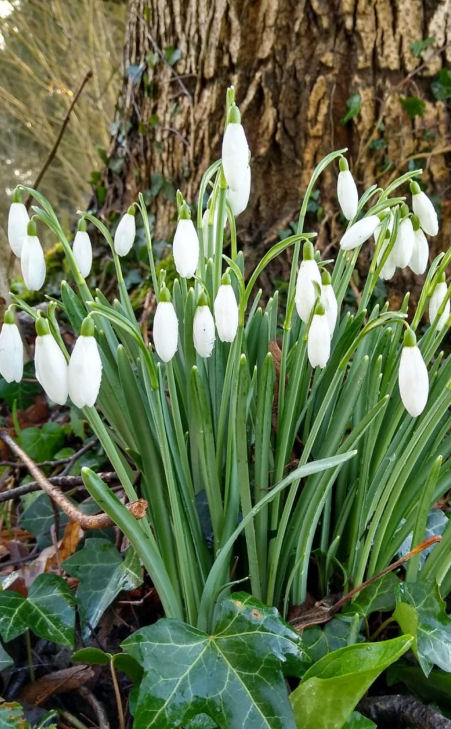 In the UK there are two flowers for January. One is the snowdrop, pictured here, and the other is the carnation which symbolises love, with the deep red carnation symbolising, not surprisingly, deep love which may explain why carnations are so popular for bouquets and weddings.
In the UK there are two flowers for January. One is the snowdrop, pictured here, and the other is the carnation which symbolises love, with the deep red carnation symbolising, not surprisingly, deep love which may explain why carnations are so popular for bouquets and weddings.
On reading more I was surprised to learn that the carnation was once used to treat fevers and, in Elizabethan times, it was used as a way to spice drinks such as wine or ale in place of more costly spices such as cloves.
Apparently it is still used today in herbal medicinal preparations, to treat nervous and coronary problems. Clearly, the carnation is not just a pretty face. There is also more to the snowdrop, the second January flower, than you might think. It seems that an extract from the flower was used by the Ancient Greeks for its mind altering qualities and was subsequently used more generally for medicinal purposes.
Whilst we might dismiss these old plant remedies as a load of nonsense, some of the old remedies were sound and effective. In the days before you could drop into Pritchard's or Boots for a tablet or some cream, those traditional remedies would have been much valued. If you want to delve a little more into the world of medieval herbs and remedies, but in a thoroughly engaging way with the odd murder thrown in, then I can recommend the Cadfael books by Ellis Peters.
Happy January to you all.
Jen Price
Happy New Year!
Top Of Page
© Abertillery & District Museum 2023 